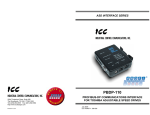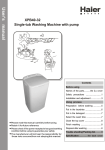Download Ladder User Manual
Transcript
93-514:ﺷﻣﺎره ﺳﻧد User Manual PROMAX Ladder’s 1 Use the Internal PLC LADDER Using the CAN OPEN protocol is enabled TASK PLC to control fast I/O. This provides for the use of special instructions that are optimized for cycle management PLC, consequently any instructions belonging to the BASIC TASK can create system malfunction. Language the PLC used is very simple and practical and can also be generated by a compiler LADDER chart. Various bits of memory instructions operate, set / reset outputs, input management, timers etc that is needed to build a functional PLC cycle. It should be noted that the PLC is shared with the TASK PLC and hence the instructions to HIGH LEVEL are handled latter’s, greatly reducing the load on the PLC. The TASK PLC has a high priority and is executed in a sampling time determined by the configuration of VTB .The Task PLC can be written with the EDITOR specific integrated in VTB or using the application PLC Ladder which consists of a graphics system contacts very simple and intuitive. ACTIVATION PLC EDITOR PLC Editor is activated by the Project window by selecting the TASK PLC ICON. Then you go to an ASCII EDITOR where you can write a PLC program using the instructions explained below. Icon for activation PLC EDITOR The PLC application is saved in the PROJECT and charged accordingly without loss of information. Enter instructions in the task PLC than those plc , may cause a malfunction of the program. NOTES ON THE TASK PLC The TASK PLC runs in a INTERRUPT at regular intervals by stopping the TASK PLC. The two TASK can share all kinds of variables being careful only with the 32-bit variables (LONG, FLOAT). This is because since the two may happen that the asynchronous TASK PLC is INTERRUPTED by the PLC when upgrading a 32-bit variable (since this requires two instructions ASSEMBLER) if the TASK PLC uses the same variable can be an incorrect reading or writing (from TASK PLC) of the variable. If the two shared variables using TASK 32-bit is recommended to select the shared variable flag in the page of page variables, VTB will perform well in automatic control. This system, however, slows the operation of the application. 2 The next system is WRONG because the control of VAR1 type LONG made in Task PLC can generate ERRORS. Example: variables used: var1 long ‘counter declared in the MAIN var3 char ‘declaration for variable bit var2 var3.1 ‘bits declared in TASK PLC used by PLC Main If var1 > 1000 …… …... endif TASK PLC PLC_LD var2 PLC_CUP var1 If you do not want to use shared variables or you want additional control, this is the correct system: Example: variables used: var1 long ‘counter declared in the MAIN var3 char ‘declaration for variable bit var2 var3.1 ‘bits declared in MAIN TASK used by PLC var4 var3.2 ‘synchronism bit of TASK Main If var4 = 1 …… …... endif ‘Check the status of bit synchronization TASK PLC PLC_LD var2 PLC_CUP var1 PLC_CMP var1 PLC_GT 1000 PLC_OUT var4 3 NOTES ON THE LIMITATION OF LADDER The ladder has limitations related to the construction of the circuit. These restrictions only concern the objects related to the family of TIMER, FACES, and FUNCTIONS .In practice these types of items shouldn’t have no right to the knot of the Circuit functional. Another limitation concerns the functions related to counters, These are considered output and therefore should always be there at the end of the block. OPERATION OF COMPILER LADDER The compiler allows you to manage LADDER PLC cycles using the classical graphical representation of electrical circuits, this greatly simplifies the management of PLC applications. In practice the PLC application is divided to blocks which contain an electrical circuit more or less complex. A block always begins with the elements of INPUT and OUTPUT ends with elements, can be inserted between these elements and processing conditioning (timers, counters, etc..). A block can be represented in its minimum configuration in the following example: In this example, the input which may be any bit of memory, determines the set of output that can be any bit of memory. The blocks may be endless, and may contain more complex networks of the previous example. BLOCK MARKER The MARKER block is used to identify the selected block. This turns solid RED when selecting BLOCK MARKER 4 SETTING OF A FUNCTION PLC A PLC function has parameters which must be set , this is done by clicking the right button on the grid that contains the PLC, and inserting in its own window pop up the various values . The parameters of each function will be described below. Gird PLC Function of containment Pop Up window parameters for inclusion SELECTION OF ONE OR MORE ELEMENTS OF A BLOCK The selection of one or more elements of a block is a very important feature of the compiler ladder, this because some functions operate only on selected items. An item is selected when the background of the grid that contains it becomes YELLOW. To select a single element of a block simply click with the left mouse button on element concerned, in addition to element is also selected the whole block (BLOCK MARKER the change of color). To select multiple items in a lock hold down the SHIFT key () on the keyboard and click with the left mouse button on the relevant elements, or select the various elements within the rectangular window designed by dragging the MOUSE. For UNCHECK one or more items, simply click the left mouse button in an empty grid. CANCELLATION AND MOVE SELECTED CANCELLATION OF SELECTED Care for the cancellation of one or more elements selected, simply press the Delete key on the keyboard. Deleted items can still be recovered with the Undo button on the menu bar. MOVE OF THE ELEMENTS SELECTED This allows you to move the selected items in the grid. To activate the shift button is selected must LOCK / UNLOCK THE ELEMENTS, as it is sufficient to click with the left mouse button on the selected items, hold it down, drag the items to the desired location. 5 MENU BUTTONS Following describes all the functionality of the toolbar buttons in the menus related to the compiler LADDER. Undo Retrieves the last I/O element block erased. LOCK / UNLOCK THE ELEMENTS It allows you to lock or unlock the displacement of selected items. COPY SELECTED ELEMENTS The selected items are copied to memory, to the actual copy, simply click with the left mouse button in the desired grid point ADD BLOCK Adds an empty block in the ladder diagram . The block is added after the last. CLEAR THE BLOCK SELECTED The block with the MARKER selected is deleted. The Undo function makes it possible to block recovery. INSERT A BLOCK AFTER THE SELECTED Is inserted into an empty block next to the one that has the MARKER selected. ADD A ROW TO BLOCK SELECTED A row is added to the block that has the selected marker. COPY ALL THE ELEMENTS OF SELECTED BLOCK All elements of the selected block are copied into memory. To make an actual copy in the grid, then click with the left mouse button in a grid point where it affects insert the new block that contains the copy of the selected one. SEARCH FOR AN ITEM Search a symbol of an element in all the blocks of application. The results will be presented in the dialog box. Clicking on the result, the block will be brought to the foreground. 6 TEXT TO LOOK INCLUSION ACTION RESULTS EXTENDING THE SEARCH FOR THE COMMENTS OF 'THE SUBJECT FIND A BLOCK Search a name of a block, the results are similar to the function Search Element. SAVE FILE PRESENT Save the 'LADDER current application. LADDER APPLICATION COMPILER The ladder application is compiled by checking various errors. If the outcome is positive is generated in an OBJECT MACRO CLASS PLC OBJ with name chosen by the compilation window .To use the PLC application filled out, simply insert the object in the MAIN PAGE of application VTB. MACRO NAME CLASS NAME OF 'THE SUBJECT COMMENT OF THE RESULTS OF COMPLETION LIST OF VARIABLES 7 DEBUG USE LADDER In this mode, displays the status of the various circuits that make up the pattern LADDER. It is useful to make the DEBUG dell application, as you can see both the state will make a force on the variables that compose the circuit. A closed loop or other assets are represented by the color GREEN .To make the FORCING of the various bits or variables, simply click with the left mouse button on the circuit concerned ,and enter the desired value in special POP UP window. POP UP WINDOW FOR FORCING BIT 8 LIST INSTRUCTIONS PLC LADDER CIRCUIT CONTACT It allows you to combine one or more objects ladder. Click on one end of an object, then click on the other end of the object to merge . Set contact through multiple ends , these will all be united. First end POINT KINGDOM Second end LOAD BIT Operation logic block start. Upload the specified bit. PARAMETERS: Variable . Name of the variable associated bit (default LDnn). Enter the name of the variable to be loaded. The variable can be existing, in this case it is declared in application VTB INITIALIZATION: A Numeric Value: Enter 0 or 1 in the INITIALIZE Do not initialize: the variable is not initialized with any value A Variable: enter the name of a variable in the BIT field DEFAULTS 9 LOAD BIT DENIED Operation logic block start. Loads the bit indicated by denying the content. PARAMETERS: Variable . Name of the variable associated bit (default LDnn). Enter the name of the variable to be loaded. The variable can be existing, in this case it is declared in application VTB INITIALIZATION: A Numeric Value: Enter 0 or 1 in the INITIALIZE Do not initialize: the variable is not initialized with any value A Variable: enter the name of a variable in the BIT field DEFAULTS Output Operation logic block end. The logical result of all the previous circuit is transferred to 'exit' s output remains active until the result is TRUE. PARAMETERS: Variable . Name of the variable associated bit (default OUTnn). Enter the name of the variable to set. The variable can be existing, in this case it is declared in application VTB INITIALIZATION: A Numeric Value: Enter 0 or 1 in the INITIALIZE Do not initialize: the variable is not initialized with any value A Variable: enter the name of a variable in the BIT field DEFAULTS OUTPUT DENIED Operation logic block end. The logical result of all the previous circuit is transferred to release denying the content, the output remains active until the result is TRUE DENIED. PARAMETERS: Variable . Name of the variable associated bit (default OUTnn). Enter the name of the variable to set. The variable can be existing, in this case it is declared in application VTB INITIALIZATION: A Numeric Value: Enter 0 or 1 in the INITIALIZE Do not initialize: the variable is not initialized with any value A Variable: enter the name of a variable in the BIT field DEFAULTS 10 Set Output Operation logic block end. Set the relay latching according to the result of the entire circuit prior-logical output remains active until it is operated RESET. PARAMETERS: Variable . Name of the variable associated bit (default SETnn). Enter the name of the variable to set. The variable can be existing, in this case it is declared in application VTB INITIALIZATION: None Reset Output Operation logic block end. Resets the relay in latching according to the logical result of the entire circuit prior-output remains reset until it is operated in a set. PARAMETERS: Variable . Name of the variable associated bit (default RESnn). Enter the name of the variable to set. The variable can be existing, in this case it is declared in application VTB INITIALIZATION: None Ondelay Timer Delay to ignition switch output, the output is activated with delay TON to ignition pulse. PARAMETERS: Time. Variable . Type Variable Delay time in milliseconds Name of the variable associated timer (default TONnn). Enter the name of the variable that contains the time. The variable can be existing, in this case it is declared in application VTB Variable type INT (max 32768 Ms) or LONG. INT variables are faster as management INITIALIZATION: A Numeric Value: enter the value in the field in Ms TIME Do not initialize: the variable is not initialized with any value A Variable: enter the name of a variable in the TIME 11 Off Delay Timer Delay shutdowns of 'exit' s output is switched off with the TOFF to delay pulse off. PARAMETERS: Time. Variable . Type Variable Delay time in milliseconds Name of the variable associated timer (default TOFFnn). Enter the name of the variable that contains the time. The variable can be existing, in this case it is declared in application VTB Variable type INT (max 32768 Ms) or LONG. INT variables are faster as management INITIALIZATION: A Numeric Value: enter the value in the field in Ms TIME Do not initialize: the variable is not initialized with any value A Variable: enter the name of a variable in the TIME Tp Timer Activate output for the time TP, the output is activated on the rising edge of the pulse, for the time indicated. PARAMETERS: Time. Variable . Type Variable Activation time in milliseconds Name of the variable associated timer (default TPnn). Enter the name of the variable that contains the time. The variable can be existing, in this case it is declared in application VTB Variable type INT (max 32768 Ms) or LONG. INT variables are faster as management INITIALIZATION: A Numeric Value: enter the value in the field in Ms TIME Do not initialize: the variable is not initialized with any value A Variable: enter the name of a variable in the TIME Rising Edge Activate output on the rising edge of the pulse. PARAMETERS: Variable . Name of the variable associated bit (default UPnn). Enter the name of the variable support. The variable can be existing, in this case it is declared in application VTB INITIALIZATION: A Numeric Value: Enter 0 or 1 in the INITIALIZE Do not initialize: the variable is not initialized with any value A Variable: enter the name of a variable in the BIT field DEFAULTS 12 Falling Edge Activate output on the falling edge of the pulse. PARAMETERS: Variable . Name of the variable associated bit (default UPnn). Enter the name of the variable support. The variable can be existing, in this case it is declared in application VTB INITIALIZATION: A Numeric Value: Enter 0 or 1 in the INITIALIZE Do not initialize: the variable is not initialized with any value A Variable: enter the name of a variable in the BIT field DEFAULTS Up Counter Increment the counter. PARAMETERS: Variable . Name of the variable associated counter variable (default CUPnn). Enter the name of the variable Support.The variable can be existing, in this case it is declared in application VTB INITIALIZATION: None Down Counter Decrements the counter. PARAMETERS: Variable . Type Variable Name of the variable associated counter variable (default CDNnn). Enter the name of the variable Support .The variable can be existing, in this case it is declared in application VTB Type of the variable CHAR INT etc. INITIALIZATION: None Reset Counter Reset the counter. PARAMETERS: Variable . Type Variable Name of the variable associated counter variable (default CRESnn). Enter the name of the variable to reset. The variable can be existing, in this case it is declared in application VTB Type of the variable CHAR INT etc. INITIALIZATION: None 13 COMPARISON OF TWO VARIABLES Compare the content of two variables. PARAMETERS Variable 1 Name of the first variable to be compared (default COMP_1nn). The variable can be any, in this case it is declared in application VTB Type var1 type variable1 CHAR or INT etc.. Variable 2 The name of the second variable to be compared (default COMP_2nn). The variable can be any,in this case it is declared in application VTB Type var2 type variable2 CHAR or INT etc.. Type Comparison Conditions for comparison. = True condition if variable1 equal to variable2 <> True condition if variable1 to variable2 different > True condition if variable1 variable2 more <True condition if less than variable1 variable2 > = True condition if greater than or equal to variable2 variable1 <= True condition if less than or equal to variable2 variable1 INITIALIZATION: A Numeric Value: enter the value in the field DEFAULTS Do not initialize: the variables are not initialized with any value A Variable: enter the name of a variable in the INITIALIZE 14 WRITING CODE VTB The TXT element allows you to write code to VTB internal application LADDER. Therefore they can be used all the instructions that recognizes VTB .This function is very powerful because it allows to optimize the LADDER application, for example by inserting cycles ENDIF IF that affect one or more blocks LADDER. In example shown below, the block 2 is scanned only when the variable AUTOMATIC is equal to 1.This in effect creates an optimization of the speed of execution of the PLC cycle, as it may exclude entire sections that are related to a condition. PARAMETERS No one INITIALIZATION None COMMENTS ALL INSIDE A BLOCK The REM element allows you to write comments all inside of a block. Since this is an OBJECT must necessarily be was added at the beginning or end of a block. Comments may contain text that is ignored, however, at the time of compilation. To enter the text you just click with the right mouse button on REM inserted object, and then enter the title and description. PARAMETERS No one INITIALIZATION None 15 TEXT LIST INSTRUCTIONS PLC PLC_LD Syntax PLC_LD Var Operation Function Variable Bit declared in MAIN. In Logical operation start the case of the compiler LADDER he thinks the statement BIT type variable declaration Var1 var.2 (original variable) Example Operation Function Variable Bit declared in MAIN. In Start logical operation the case of the compiler LADDER he denied thinks the statement Example BIT type variable declaration Var1 var.2 (original variable) PLC_LDN var1 Operation Function Variable Bit declared in MAIN. In Logical AND operation the case of the compiler LADDER he thinks the statement Example Variable declaration Var1 var.2 Var2 var.1 PLC_LD var1 PLC_LDN Syntax PLC_LDN Var PLC_AND Syntax PLC_AND Var PLC_LD Var2 PLC_AND Var1 PLC_ANDN Syntax PLC_ANDN Var Operation Function Variable Bit declared in MAIN. In Logical AND DENIED the case of the compiler LADDER he thinks the statement Example Variable declaration Var1 var.2 Var2 var.1 PLC_LD Var2 PLC_ANDN Var1 PLC_OR Syntax PLC_OR Var Operation Function Variable Bit declared in MAIN. In Logical OR operation the case of the compiler LADDER he thinks the statement Example Variable declaration Var1 var.2 Var2 var.1 PLC_LD Var2 PLC_OR Var1 16 PLC_ORN Syntax PLC_ORN Var Operation Function Variable Bit declared in MAIN. In Logical operation OR the case of the compiler LADDER he DENIED thinks the statement Example Variable declaration Var1 var.2 Var2 var.1 PLC_LD Var2 PLC_ORN Var1 PLC_PUSH Syntax ACC Operation Function PUSH dell ACC in STACK PLC_PUSH Example Variable declaration Var1 var.2 Var2 var.1 PLC_LD Var2 PLC_OR Var1 PLC_PUSH PLC_ANDS Syntax ACC Operation Function Logical AND STACK with the ACC PLC_ANDS Example Variable declaration Var1 var.2 Var2 var.1 Var3 var.3 PLC_LD var2 PLC_OR var1 PLC_PUSH PLC_LD var3 PLC_ANDS PLC_ORS Syntax ACC Operation Function Logical OR STACK with the ACC PLC_ORS Example Variable declaration Var1 var.2 Var2 var.1 Var3 var.3 PLC_LD var2 PLC_OR var1 PLC_PUSH PLC_LD var3 PLC_ORS 17 PLC_OUT Syntax PLC_OUT Operation Function Variable Bit declared in MAIN. In Sends the contents of the case of the compiler LADDER he the accumulator in the thinks the statement BIT output Example Variable declaration Var1 var.2 PLC_LD var1 PLC_OUT PLC_OUTN Syntax PLC_OUTN Operation Function Variable Bit declared in MAIN. In Send the contents of the case of the compiler LADDER he DENIED in BIT thinks the statement accumulator output Example Variable declaration Var1 var.2 PLC_LD var1 PLC_OUTN PLC_SET Syntax PLC_SET PLC_RES Syntax PLC_RES Operation Function Variable Bit declared in MAIN. In Set the relay in SELF the case of the compiler LADDER he based on the content thinks the statement of ACCUMULATOR Operation Function Variable Bit declared in MAIN. In Resets the relay in the case of the compiler LADDER SELF based on the he thinks the statement content of ACCUMULATOR 18 Example Variable declaration Var1 var.2 PLC_LD var1 PLC_SET Example Variable declaration Var1 var.2 PLC_LD var1 PLC_RES PLC_TON Syntax PLC_TON Operation Variable vector of positions 2 or UINT or LONG declared in MAIN. In the case of the compiler LADDER he thinks the declaration and all INITIALIZATION. NOTES: Not using the compiler LADDER need to initialize the variable in the INIT MAIN. Where VARIABLE (0) contains the millisecond value of the TARGET TIMER, VARIABLE (1) contains the starting value and the present value Function Delay to ignition switch output. The output is activated with delay TON to ignition pulse. Example Variable declaration Var1 var.2 Var2 var.1 Tempo(2) as long The output can be any one of the blocks PLC_OUT PLC_OUTN PLC_SET PLC_RES Initialize TIMER Tempo(0) = 1000 ‘ 1 sec Tempo(1)=1000 ‘ 1 sec Function Off Delay of output. The output is switched off with the TOFF to delay pulse off. Example Variable declaration Var1 var.2 Var2 var.1 Tempo(2) as long PLC_LD var1 PLC_TON tempo() PLC_SET var2 PLC_TOFF Syntax PLC_TOFF Operation Variable vector of positions 2 or UINT or LONG declared in MAIN. In the case of the compiler LADDER he thinks the declaration and all INITIALIZATION. NOTES: Not using the compiler LADDER need to initialize the variable in the INIT MAIN. Where VARIABLE (0) contains the millisecond value of the TARGET TIMER, VARIABLE (1) contains the starting value and the present value The output can be any one of the blocks PLC_OUT PLC_OUTN PLC_SET PLC_RES 19 Initialize TIMER Tempo(0) = 1000 ‘ 1 sec Tempo(1)=0 PLC_LD var1 PLC_TOFF tempo() PLC_SET var2 PLC_TP Syntax PLC_TP Operation Variable vector of positions 2 or UINT or LONG declared in MAIN. In the case of the compiler LADDER he thinks the declaration and all INITIALIZATION. Function Activate output for the time TP. The output is activated on the rising edge of the accumulator. NOTES: Not using the compiler LADDER need to initialize the variable in the INIT MAIN. Where VARIABLE (0) contains the millisecond value of the TARGET TIMER, VARIABLE (1) must be CLEARED The output can be any one of the blocks PLC_OUT PLC_OUTN PLC_SET PLC_RES Operation CHAR or UCHAR variable declared in MAIN. In the case of the compiler LADDER he thinks the statement. The variable must be initialized with the INIT MAIN DEFAULT value of the STATE Function Turning on the FRONT OUTPUT RISE of BATTERY. Example Variable declaration Var1 var.2 Var2 var.1 Tempo(2) as long Initialize TIMER Tempo(0) = 1000 ‘ 1 sec Tempo(1)=0 ‘ reset PLC_LD var1 PLC_TP tempo() PLC_SET var2 PLC_UP Syntax PLC_UP The output can be any one of the blocks PLC_OUT PLC_OUTN PLC_SET PLC_RES 20 Example Var1 var.2 Var2 var.1 Old_stato as char Initialization STATE Old_stato=0 PLC_LD var1 PLC_UP old_stato PLC_OUT PLC_DOWN Syntax PLC_DOWN Operation CHAR or UCHAR variable declared in MAIN. In the case of the compiler LADDER he thinks the statement. The variable must be initialized with the INIT MAIN DEFAULT value of the STATE Function OUTPUT FACE DOWN on the activation of the ACC. The output can be any one of the blocks PLC_OUT PLC_OUTN PLC_SET PLC_RES Example Variable declaration Var1 var.2 Var2 var.1 Old_stato as char Initialization STATE Old_stato=0 PLC_LD var1 PLC_DOWN old_stato PLC_OUT PLC_CUP Syntax PLC_CUP Operation Variable LONG - INT - UINT - CHAR UCHAR declared in MAIN. In the case of the compiler LADDER he thinks the statement. The variable can be pre-set at any TASK VTB. Function Example UP counter. The count Variable declaration is INCREASED if the ACC Var1 var.2 is ON Contad long Operation Variable LONG - INT - UINT - CHAR UCHAR declared in MAIN. In the case of the compiler LADDER he thinks the statement. The variable can be pre-set at any TASK VTB. Function Example UP counter. The count Variable declaration is INCREASED if the ACC Var1 var.2 is ON Contad long Operation Variable LONG - INT - UINT - CHAR UCHAR declared in MAIN. In the case of the compiler LADDER he thinks the statement. Function Reset based on the contents of the accumulator counter the UP or DOWN PLC_LD var1 PLC_CUP contad PLC_CDOWN Syntax PLC_CDOWN PLC_LD var1 PLC_CDOWN contad PLC_CRES Syntax PLC_CRES 21 Example Variable declaration Var1 var.2 Conta long PLC_LD var1 PLC_CRES conta PLC_CMP Syntax PLC_CMP Operation Variable to compare LONG - INT UINT - CHAR - UCHAR declared in the MAIN or CONSTANT inserted directly. In the case of the compiler LADDER he thinks the statement. Function Comparison of two variables Example Variable declaration Var1 int Var2 int PLC_CMP var1 PLC_EQ var2 (see var1=var2 accumulatore=1) NOTES: PLC_CMP phase begins for comparison (in LADDER is not present) must be followed by one of the following instructions: PLC_EQ PLC_NE PLC_GT PLC_GE PLC_LT PLC_LE PLC_EQ Syntax PLC_EQ Operation Variable Comparison LONG - INT UINT - CHAR - UCHAR declared in the MAIN or CONSTANT inserted directly. In the case of the compiler LADDER he thinks the statement. Function Comparison if EQUAL. If the two variables are the SAME content of accumulator is set to 1 (TRUE) NOTES: The education PLC_EQ must always be preceded by: PLC_CMP Var1 22 Example Variable declaration Var1 int Var2 int PLC_CMP var1 PLC_EQ var2 ( see var1=var2 accumulatore=1) PLC_NE Syntax PLC_NE Operation Variable Comparison LONG - INT UINT - CHAR - UCHAR declared in the MAIN or CONSTANT inserted directly. In the case of the compiler LADDER he thinks the statement. NOTES: The education PLC_NE must always be preceded by: Function Comparison if DIFFERENT. If the two variables are DIFFERENT the content of accumulator is set to 1 (TRUE) Example Variable declaration Var1 int Var2 int PLC_CMP var1 PLC_NE var2 ( se var1=var2 accumulatore=1) PLC_CMP Var1 PLC_GT Syntax PLC_GT Operation Variable Comparison LONG - INT UINT - CHAR - UCHAR declared in the MAIN or CONSTANT inserted directly. In the case of the compiler LADDER he thinks the statement. NOTES: The education PLC_GT must always be preceded by: Function Example Comparison if AJEURE. If the variable VAR1 VAR2 is GREATER than the content of accumulator is set to 1 (TRUE) Variable declaration Var1 int Var2 int PLC_CMP var1 PLC_GT var2 PLC_CMP Var1 PLC_GE Syntax PLC_GE Operation Variable Comparison LONG - INT UINT - CHAR - UCHAR declared in the MAIN or CONSTANT inserted directly. In the case of the compiler LADDER he thinks the statement. NOTES: The education PLC_GE must always be preceded by: Function Comparison if Greater than. If the variable VAR1 to VAR2 is greater than the content of accumulator is set to 1 (TRUE) PLC_CMP Var1 23 Example Variable declaration Var1 int Var2 int PLC_CMP var1 PLC_GE var2 PLC_LT Syntax PLC_LT Operation Variable Comparison LONG - INT - UINT - CHAR - UCHAR declared in the MAIN or CONSTANT inserted directly. In the case of the compiler LADDER he thinks the statement. Function Example Comparison if LESS. If the variable VAR1 VAR2 is LESS than the content of accumulator is set to 1 (TRUE) Variable declaration Var1 int Var2 int Function Comparison Less than though. If the variable VAR1 VAR2 is less than or equal to the contents of the accumulator is set to 1 (TRUE) Example Variable declaration Var1 int Var2 int NOTES: The education PLC_LT must always be preceded by: PLC_CMP var1 PLC_LT var2 PLC_CMP Var1 PLC_LE Syntax PLC_LE Operation Variable Comparison LONG - INT UINT - CHAR - UCHAR declared in the MAIN or CONSTANT inserted directly. In the case of the compiler LADDER he thinks the statement. NOTES: The education PLC_LE must always be preceded by: PLC_CMP Var1 24 PLC_CMP var1 PLC_LE var2





































